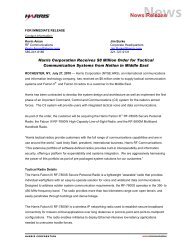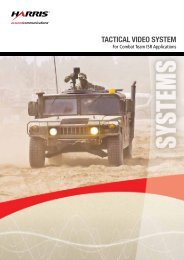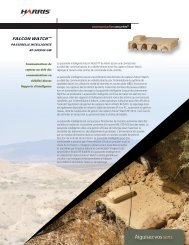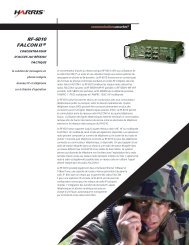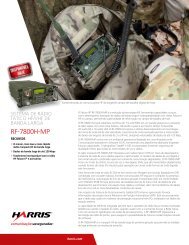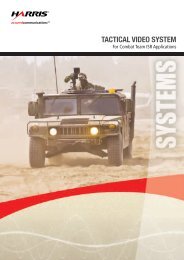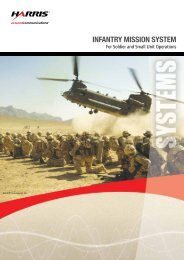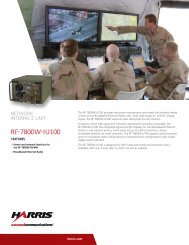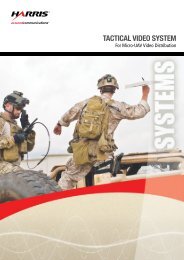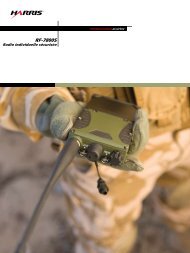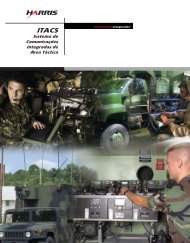TACTiCAl MEDiCAl TriAgE SYSTEM - Harris Corporation
TACTiCAl MEDiCAl TriAgE SYSTEM - Harris Corporation
TACTiCAl MEDiCAl TriAgE SYSTEM - Harris Corporation
Create successful ePaper yourself
Turn your PDF publications into a flip-book with our unique Google optimized e-Paper software.
THE OPERATIONAL challenge<br />
Seamless capture and transfer of medical data<br />
to save lives on the battlefield<br />
Combat medics must not only treat patients under<br />
battlefield conditions, but also document the injuries<br />
and their treatment. This information needs to be rapidly<br />
dispatched to a medical center so that time-critical care can be<br />
planned and provided. Currently there is no integrated system<br />
that supports both the recording and transmission of this<br />
medical data in theater. Doctors are therefore not receiving this<br />
important—sometimes lifesaving—information quickly enough<br />
to effectively manage treatment.<br />
Today’s in-field data capture methods do not provide a quick and<br />
efficient means for recording medical information. The standard<br />
method is to simply write on a patient’s body or a paper form<br />
with a grease pencil. More advanced methods involve using a<br />
PDA to generate an electronic record, but these have numerous<br />
drawbacks. The complicated user interface makes them<br />
cumbersome and difficult to use. In fact, the process of collecting<br />
data at the time of an injury typically requires extensive use of<br />
both hands. This can interfere with overall patient care or require<br />
additional assistance for transcription.<br />
Another major drawback with current systems is that the injury<br />
and treatment data remains with the patient or medic; this<br />
information can be easily lost or compromised in the field.<br />
Doctors are therefore not prepared to immediately treat the<br />
patient, and critical care is delayed while the pertinent data is<br />
collected again.<br />
Many militaries have established medical data repositories<br />
to ensure that injury data and medical treatment information<br />
are available for follow-on treatments, rehabilitation, and<br />
determination of wartime benefits. Since the data manually<br />
captured at the point of injury does not automatically populate<br />
a centralized data repository, the medic must manually enter<br />
the information into a computer at the treatment facility. Any<br />
information that was recorded on a PDA-based system also<br />
requires an additional step to synchronize it with the database,<br />
since current devices do not transmit the data over tactical radio<br />
networks.<br />
The main liabilities of the current systems include:<br />
l Inability to supply triage data to doctors prior to patient arrival<br />
l Manual data entry methods that require the use of one or<br />
both hands<br />
l Inability to wirelessly transmit data to or update medical<br />
databases<br />
l Documentation of medical status requires additional steps<br />
l Data from the point of injury is often lost or damaged,<br />
possibly impacting outcomes<br />
The optimal solution would convey medical triage data from field<br />
medics to waiting doctors—and into the healthcare system at<br />
large—with a design that is both cost-effective and adaptable to



